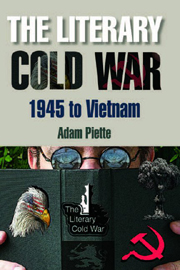Book contents
- Frontmatter
- Contents
- Acknowledgements
- Introduction
- 1 The Special Relationship and the British Hypothesis: The Black Laurel, The Third Man, Cold War Vienna and Berlin
- 2 Cold War on the 1930s and Sacrificial Naming: John Dos Passos and Josephine Herbst
- 3 DEW Line, Uranium and the Arctic Cold War: Ginsberg's Kaddish and Nabokov's Lolita
- 4 Cold War Sex War, Or the Other Being Inside: Burroughs, Paley, Plath, Hughes
- 5 The Sacrificial Logic of the Asian Cold War: Greene's The Quiet American and McCarthy's The Seventeenth Degree
- Conclusion
- Bibliography
- Index
3 - DEW Line, Uranium and the Arctic Cold War: Ginsberg's Kaddish and Nabokov's Lolita
Published online by Cambridge University Press: 12 September 2012
- Frontmatter
- Contents
- Acknowledgements
- Introduction
- 1 The Special Relationship and the British Hypothesis: The Black Laurel, The Third Man, Cold War Vienna and Berlin
- 2 Cold War on the 1930s and Sacrificial Naming: John Dos Passos and Josephine Herbst
- 3 DEW Line, Uranium and the Arctic Cold War: Ginsberg's Kaddish and Nabokov's Lolita
- 4 Cold War Sex War, Or the Other Being Inside: Burroughs, Paley, Plath, Hughes
- 5 The Sacrificial Logic of the Asian Cold War: Greene's The Quiet American and McCarthy's The Seventeenth Degree
- Conclusion
- Bibliography
- Index
Summary
In May 1955, Allen Ginsberg began training as a Military Sea Transport Service yeoman-storekeeper in order to fund a trip to Europe. He served on the cargo ship USNS Sgt. Jack J. Pendleton, which, after several short trips along the Eastern seaboard, would eventually sail to the Arctic Circle. Just before leaving for the north, Ginsberg's mother, Naomi, died, on 9 June 1956, and it is a poignant fact that the journey to the polar regions coincided with his difficult mourning for his Russian mother, for the journey took him through the Bering Strait, the contact point between American Alaska and the Soviet Union.
From the very beginning, indeed, the fact of his engagement in the US Navy became nightmarishly embroiled with his attempts properly to perform the necessary Kaddish for his mother's spirit. Unable to attend her funeral on 11 June, he was distressed to learn from his father that there had not been enough men at the graveside to have a Kaddish read – the service demands at least ten men; there were only seven in the cortege. Ginsberg decided he would have to write one himself, but found the Cold War was getting in the way. In a journal entry that month, Ginsberg wrote:
Everything changes toward death. My mother. Myself. The asphalt pavement of the dock I am sitting on. The chair I am sitting on is labeled consigned for scrap. Along the dock, blue water, blue sky. […]
- Type
- Chapter
- Information
- The Literary Cold War 1945 to Vietnam , pp. 74 - 105Publisher: Edinburgh University PressPrint publication year: 2009

